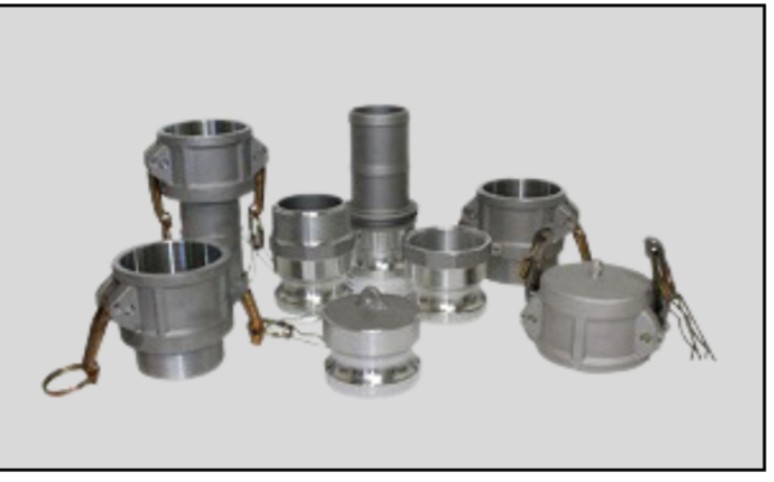Camlock fittings, also known as cam and groove couplings, are essential components in various industries. And why wouldn’t they be? After all, they help connect and disconnect hoses and pipes efficiently. These fittings are popular for their ease of use, versatility, and reliability. While many people are pretty much equipped with knowledge, some are quite amateur, too.
This is why we are here to inform you of everything you should be well aware of before you search for camlock fittings near me and decide to buy them. In this blog, we will explore the different types of camlock fittings, their common applications, and how to choose the right one for your specific needs. First, let’s discuss the types of camlock fittings.
The Different Types of Camlock Fittings:
Camlock fittings come in several types, each designed to cater to specific applications and industry requirements. The primary types include Type A, B, C, D, E, F, DC (Dust Cap), and DP (Dust Plug). Let’s delve into each type and understand their unique characteristics:
- Type A
The Type A Camlock fittings feature a male adapter with a female NPT thread on the opposite end.
Applications: These fittings are commonly used in applications where the male adapter needs to be connected to a female-threaded pipe or hose. They are quite useful in situations where a secure and quick connection to a female NPT is essential. They are often found in industrial settings like water pumps, fuel transfers, and agricultural settings.
- Type B
The Type B Camlock fittings have a female coupler with a male thread. They basically have a female cam coupling at one end and a male NPT thread at the other end.
Applications: Type B fittings are versatile and used when a female coupler needs to connect to a male-threaded pipe or hose. These fittings are suitable for use in agriculture, petroleum, and wastewater management industries.
- Type C
The Type C Camlock fittings consist of a female coupler with a hose tail.
Applications: These fittings are ideal for connecting hoses in applications requiring a secure and quick-disconnect connection. They are commonly used in the food and beverage industry, irrigation, water transfers, and other liquid forms.
- Type D
The Type D Camlock fittings have a female coupler at one end and a female thread at the other.
Applications: The Type D fittings are used when a female coupler needs to be connected to a male NPT thread. They are often found in chemical transport, water treatment, and food processing applications.
- Type E
The Type E Camlock fittings feature a male adapter with a hose tail.
Applications: These fittings are suitable for applications requiring the connection of hoses to male adapters. They are widely used in agriculture, firefighting, and industrial fluid transfer.
- Type F
The Type F Camlock fittings come with a male adapter and a male thread.
Applications: Type F fittings are used to connect hoses to female-threaded pipes or hoses. They are common in industries dealing with oils, fuels, and chemicals.
- Type DC (Dust Cap)
They are not the traditional camlock fittings. The Type DC Camlock fittings are basically the dust caps designed to cover male adapters.
Applications: Dust caps are essential for protecting the male adapters from contamination and damage when not in use. They help in environments or areas where cleanliness and safety are paramount.
- Type DP (Dust Plug)
Last but not least, the Type DP Camlock fittings are dust plugs designed to cover female couplers.
Applications: Dust plugs protect female couplers from dirt, debris, and damage when they are not connected to a hose or pipe. They are quite useful in industrial and agricultural settings.
Common Applications for Each Type
Camlock fittings are incredibly versatile and find applications across a wide range of industries. From handling hazardous materials to facilitating fluid transfer in sanitary environments, they prove to be essential components in numerous processes. So, let’s take a closer look at the common uses for each type of fitting.
- Type A: Industrial and agricultural piping systems.
- Type B: Chemical processing and water treatment systems.
- Type C: Food and beverage industry, liquid transfer.
- Type D: Petroleum and chemical industries.
- Type E: Agriculture, firefighting, industrial fluid transfer.
- Type F: Oil, fuel, and chemical industries.
- Type DC (Dust Cap): Protection of male adapters in various industries.
- Type DP (Dust Plug): Protection of female couplers in industrial and agricultural settings.
Choosing the Right Camlock Fitting for Your Needs
Selecting the right Camlock fitting for your application can be crucial for ensuring efficiency, safety, and reliability. Here are some factors to consider when choosing the appropriate Camlock fitting:
- Material
Camlock fittings are available in various materials, including stainless steel, aluminum, brass, and polypropylene. The choice of material should be based on the type of fluid being transferred and the environmental conditions. For example, stainless steel is ideal for corrosive environments, while polypropylene is suitable for lightweight and non-corrosive applications.
- Size
Camlock fittings come in different sizes, typically ranging from 1/2, 2″ camlock to 6 inches. Ensure that the fitting size matches the diameter of your hose or pipe to guarantee a secure and leak-free connection.
- Gender
Based on the connection requirements of your hose or pipe system, determine whether you need a male or female fitting. This will help you choose between adapters (Type A, E, F) and couplers (Type B, C, D).
- Application
Consider the specific application and industry requirements. For instance, if you are in the food and beverage industry, Type C fittings may be more suitable due to their ease of use and secure connections for liquid transfer.
- Environmental Conditions
Take into account the environmental conditions in which the Camlock fittings will be used. If your application involves exposure to harsh chemicals or extreme temperatures, opt for fittings made from materials that can withstand such conditions.
- Safety and Maintenance
Finally, consider the fittings’ safety and maintenance aspects. Dust caps (Type DC) and dust plugs (Type DP) are essential for protecting the fittings from contamination and damage, ensuring a longer lifespan and reliable performance.
Conclusion
Camlock fittings are indispensable components in a wide range of industries. They offer efficient and versatile solutions for connecting and disconnecting hoses and pipes. By understanding the different types of Camlock fittings and their applications, you can make informed decisions and choose the right fittings for your specific needs. Whether in agriculture, chemical processing, or the food and beverage industry, a Camlock fitting is designed to meet your requirements. These fittings ensure nothing but the smoothest operation of your fluid transfer systems.



